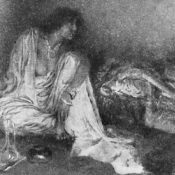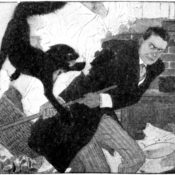Originally published in the Post on May 22, 1920.
Of course, we did have our bits of the higher life once in a while in the old days. Whenever the husbands could be argued into it we used to take up the rugs and devote the evening to Terpsichore, as the boys say. But we got little or nothing out of it, considering all the effort involved. The talent for dancing among the male element of our set would, if pooled, be about equal to the histrionic ability of Mr. Jack Dempsey. The only one who really worked up any enthusiasm about it was old Mr. Emery, who as a parlor Maurice had one foot in the grave and the other on his partner’s instep. He had taken up dancing along about the time that the waltz was being condemned by press and pulpit, and his idea of a really good jazz number was “Do You See My New Shoes?”
|
As the Spirit Moves |
| Part I: The New, Prohibition-Era Pastime |
| Part II: The Age of the Ouija Boards |
| Part III: When the Bridge Hounds Were Unleashed |
| Part IV: Henry G. Takes to Verse |
| Part V: Aunt Bertha’s Snappy Work |
| Part VI: Mrs. Couch & Mrs. Thill |
| Part VII: Too Much Is Enough |
The community dances never went over really big, that you could mention; by the time the second fox trot had reached the place where the record was scratched the men had all gathered in one corner and were arguing about how long you ought to let it stand before you put it in the still; and the women were settled along the other side of the room, telling each other how you could reduce without exercising or dieting. Those evenings were apt to cause hard feeling between husband and wife, and one word frequently led to another on the way home. Then there was the time that we went in rather heavily for bridge. The bridge hounds were unleashed on Tuesday evenings, and at eleven o’clock chicken salad and lettuce sandwiches would be served and the one who had the highest score could choose between a blue glass candy jar with a glass crab apple on its top, and a hive-shaped honey pot of yellow china with china bees that you’d swear were just about to sting you swarming all over it; in either case what was left went without any argument to the holder of the next highest score. On the next Tuesday the club would meet again, and play till eleven o’clock, at which time chicken salad and cream cheese and olive sandwiches would be provided, and the winner had to make up his mind between one of those handy little skating girls made of painted wood with a ball of colored twine instead of a bodice, and a limp-leather copy of Gitanjali, by Rabindranath Tagore, the well-known hyphenated Indian. The bridge club would doubtless have still been tearing things wide open every Tuesday, but the Ouija board came in, and the hostesses’ imagination in the selection of prizes gave out, at about the same time. Mrs. Both, who is awfully good at all that kind of thing, tried to inaugurate a series of Sunday evening intellectual festivals, but they were never what you could really call a riot. The idea was that everyone should meet at her house, and the more gifted among us should entertain and at the same time elevate the majority. But Mrs. Both could never get enough backing from the rest of the home talent. She herself read several papers that she had written on such subjects as The New Russia, and Why; and Modern Poetry-What of Its To-Morrow?
Become a Saturday Evening Post member and enjoy unlimited access. Subscribe now



